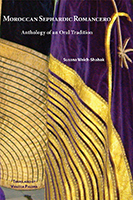Moroccan Sephardic Romancero
Anthology of an Oral Tradition
Susana Weich-Shahak
Most of the book consists of the anthology of the song texts and their variations. In this section Dr. Weich-Shahak gives part of the social context of the songs.
Sample
The Woman in the Sephardic Romancero
Referring to the Spanish romancero (collection of folk ballads) Diego Catalán said that “women throughout the centuries have had the dominant role in transmission of the romancero” (1984: 21). He also says that “it is possible that women have a more dominant voice than men.” In Sephardic musical repertoire, and specifically referring to women’s roles in the romancero manifest in a double aspect. On the one hand, she is the preserver of this tradition and its principal transmitter in communal rites and in exclusively feminine events. On the other hand, we can observe women as characters in the romances where as Diego Catalán says “she puts the known world on trial and this should be considered as an expression of a feminine perspective.”
In the Sephardic world, while men fulfill their role in everything that regards the preservation and transmission of Hebrew liturgy and paraliturgical repertoire, the Sephardic woman is without a doubt the main transmitter of the romancero and cancionero. She is its most faithful carrier and repository. When I have recorded a man interpreting a romance (folk ballad), he always spontaneously informs me that he learned it from a woman: his mother, aunt or grandmother. Precisely because the conservation and transmission of the romancero are a direct consequence of its principal function as lullaby, there is an opportunity for older children to learn them when they hear them sung as lullaby to a younger sibling.
The conservation of the Sephardic romancero repertoire is linked to its function in the cycle of life. Women would sing romances for all night vigils next to the bed of a mother who has just given birth. With these songs they would protect her and her child during the eight days preceding the circumcision. Singing romances they would accompany the preparations for a wedding and the elaboration of the bride’s trousseau. Also during days of family mourning the women had an important role: there were appropriate songs called oínas or endechas amongst which there were mournful romances. Women also sang certain romances that referred to holidays in the Jewish yearly cycle.
Regarding woman’s role as an important character in the romancero, one must note that in romance narrative all the central figures are female. Giussepe Di Stefano talks about the general romancero saying: “in the Romancero, feminine protagonism is well constructed and highly developed. It serves as a powerful parable of feminine power through an imaginary universe gathered from various origins. The romancero functions as a manner of implementing suggestions and even compensation for behavior” (1993:53). In fact, it is almost always a woman that propels the plot of the romance forward. She is the one to do and undo, it is she who moves the narrative, or she is the central focus of the story of the romance (ballad).
In romance texts woman appears in various roles and many of them relate to honor. In the romancero there is a clear distinction between a man’s honor and a woman’s honor (Anahory-Librowicz 1982, 1994). A man’s honor is wide and dynamic, usually related to his actions. He can increase his honor, lose it and regain it. A woman’s honor is connected to her physiological self, her sexual conduct. It can only be lost and ruined. She can never regain it. Because of this, honor that is lost because of adultery is punished harshly as in the romance Landarico o La reina adúltera (#50). In the romance the world is divided into public and private spaces. The public, exterior space is presented as belonging to the male, while the woman is consigned to the interior, domestic, private world. This is why transitional spaces such as the window, the balcony and the lattice become so important (Suárez Robaina 2003: 109-191).
Another role is of the woman as victim. In these cases the plot’s main character and driving force is the victim. One of the most evident examples of this is the ballad of Delgadina (#58) when her father punishes her because she will not accept his incestuous seduction. The rest of the family also shuns Delgadina when she turns to them for help. It is precisely the parallel repetition found in the dialogue between Delgadina and her family members (sisters, brother and mother) that signal to the gravity of the problem. It exposes the girl’s anguish when faced with their indifference and rejection when she asks for help.
The betrayed woman is found in the ballad of La mujer engañada (#43). She sings to her son of her husband’s betrayal, telling him how she followed him and saw him walking into his lover’s house. By the end of the romance we see the main character as a resolute and audacious woman who has decided to not open the door to her husband when he returns and lies about his amorous escapade.
Another mistreated woman is the protagonist of the ballad La mala suegra (#40). She suffers from her mother-in-law’s antagonism and calumny. The mother-in-law approves that her pregnant daughter-in-law should go to her parent’s castle to give birth and takes advantage of her absence to speak badly about her to her son. He is convinced by his mother’s argument and furiously leaves to kill the poor new mother. These last two examples show repeated versions of the suffering and unfortunate woman (Ruiz Fernández 1990).
Woman appears as victim of the conflicts created by war that appear in romances with texts that refer to the Reconquista period. Themes about captives and prisoners as in La Hermana reina y cautiva (#19) reappear in the romance of La hermana cautiva (Don Bueso y su hermana) (#20, 21). In the latter, the pain of a kidnapping, an averted case of incest and the joy of the family reunion are all combined into one story.
The importance of the female character in the romancero created a manner for Sephardic women to identify themselves or judge, evaluate, criticize and compensate their own social and familial situation. Michelle Debax states it clearly that it represents “…archetypic conflicts that can be current for every interpreter and every listener.” (1882, 1978:316)
ISBN 9781935604105 Cloth. 256 pages. $44.95
ISBN 9781935604556 Paper. 256 pages. $29.95
For information on group orders from Gaon Books
Call 505.920.7771
or e-mail gaonbooks@gmail.com
Distributed to the book industry by Ingram and others
Gaon Books
Excellence in Publishing


